Stormwater Management: Designing Effective Drainage Systems


Overview of the Topic
Definition and Importance
Current Trends
Amid increasing climate uncertainties and the push towards sustainable farming, innovative strategies in drainage system design have emerged. Technologies such as Geographic Information Systems (GIS) are increasingly adopted for site assessments, enabling farmers to make data-driven decisions. Furthermore, integrating constructed wetlands and bioretention systems into traditional drainage designs has gained traction, aligning with environmental sustainability goals and enhancing biodiversity. These trends signify a shifting paradigm in agricultural water management where the health of the ecosystem is just as vital as crop output.
Key Techniques and Practices
Step-by-Step Guide
When designing a drainage system, following a systematic approach is crucial for achieving the desired outcomes. Consider this step-by-step guide:
- Site Assessment: Evaluate the topography, soil types, and existing land use to identify water flow patterns. This step involves field surveys and spatial analysis.
- Material Selection: Choose appropriate materials based on local conditions and sustainability considerations. This may include natural filters like gravel or synthetic options like perforated pipes.
- Design Methodology: Implement design principles that support effective drainage. Techniques such as contour farming can be integrated to work with the natural landscape.
- Installation: Execute the plans carefully, ensuring all components are aligned and functional. Paying attention to details during installation can prevent future complications.
- Maintenance Plan: Develop a routine maintenance plan to address any sediment build-up or system blockages. Regular checks will extend the life of the drainage system.
Tools and Equipment Needed
To carry out this design effectively, certain tools and equipment are essential:
- Surveying Equipment: Levels and theodolites for accurate land assessment.
- Soil Test Kits: To analyze soil composition and drainage capacity.
- Excavators and Backhoes: Needed for infrastructure installation.
- Water Level Monitoring Devices: These instruments help in assessing the effectiveness of the drainage system over time.
Challenges and Solutions
Common Obstacles
Despite the best planning, various challenges can impede effective stormwater management. Some of these include:
- Soil Compaction: Heavy machinery can lead to soil density issues that hinder drainage efficiency.
- Climatic Variability: Unpredictable rainfall and severe weather events can overwhelm drainage systems.
- Regulatory Constraints: Complying with local regulations can introduce complexities in design and implementation.
Innovative Solutions
To tackle these challenges, adopting creative solutions is vital:
- Adaptive Management: Regularly modifying strategies based on observed performance and environmental changes can optimize system effectiveness.
- Incorporating Vegetative Solutions: Employing plants, particularly native species, can enhance natural filtration and stabilize soil, making the drainage system more resilient.
- Community Engagement: Collaborating with local stakeholders and engaging in community awareness programs can help facilitate better management practices.
"Effective stormwater management is not merely an engineering challenge but a holistic approach that necessitates collaboration, innovation, and a deep respect for nature."
Intro to Stormwater Drainage
In agricultural settings, managing stormwater effectively is not merely a nice-to-have; it's crucial for operational success. Drainage systems are at the heart of this endeavor, guiding excess water away from fields and preventing potential crop damage. Poorly managed stormwater can lead to various problems such as soil erosion, reduced crop yields, and even more severe ecological consequences. Hence, understanding drainage design is indispensable for farmers who want to optimize their land use and mitigate the effects of heavy rainfall.
Understanding Stormwater Management
Stormwater management is the strategic approach to handling rainfall and surface runoff. It goes beyond just disposing of excess water; it's about using the right techniques and systems to ensure that water flows efficiently without eroding or contaminating valuable land. There are several fundamental principles at play:
- Capture and Control: The goal is to capture as much stormwater as possible to prevent flooding and soil erosion.
- Detention and Retention: These systems temporarily hold water to allow for proper absorption into the ground rather than letting it all rush off and cause chaos.
- Quality Improvement: Filtering pollutants from stormwater not only protects crops but also maintains local ecosystems.
Understanding these principles lays the groundwork for effective drainage systems and sustainable agricultural practices. In many cases, incorporating green infrastructure—like rain gardens or vegetated swales—can enhance traditional drainage methods and have a positive environmental impact.
Importance of Effective Drainage Systems
The significance of efficient drainage systems cannot be overstated. Think of a farm having a major rainstorm without a solid plan in place—it's a recipe for disaster. Here are a few critical advantages of well-designed drainage systems:
- Prevention of Crop Damage: Excess water can saturate the soil, leading to root rot and other fungal issues. An effective drainage system minimizes these risks by properly channeling water away.
- Soil Fertility Maintenance: By preventing waterlogging, good drainage helps maintain the right balance of moisture levels, ensuring that essential nutrients remain available to crops.
- Improved Access and Field Conditions: Farmers can work their fields sooner after rains if the stormwater drains away effectively, enabling better crop management and timely planting.
"An ounce of prevention is worth a pound of cure." This idiom rings true for drainage systems—investing time and resources into designing effective systems upfront saves farmers from facing larger problems down the road.
Ultimately, effective stormwater drainage is key to sustainable agriculture. Not only does it empower farmers to better utilize their land, but it also contributes to broader environmental goals. As the climate continues to change and precipitation patterns grow more unpredictable, reliance on well-structured drainage systems is becoming increasingly vital.
Key Components of Drainage Design
When diving into the design of drainage systems, one must ponder the critical components that serve as the backbone of an effective stormwater management strategy. Hitting the nail on the head requires a thorough understanding of these elements, as they directly influence both the functionality and sustainability of agricultural practices. The interplay between design elements not only assists in optimizing water flow but also assures that the ecological balance is upheld. Gone are the days where farming relied solely on rainfall; a well-thought-out drainage system can significantly mitigate water-related issues, making it paramount for modern farming.
Site Assessment Techniques
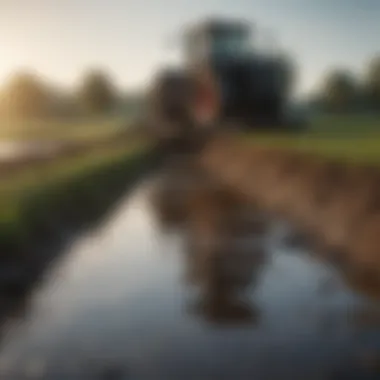
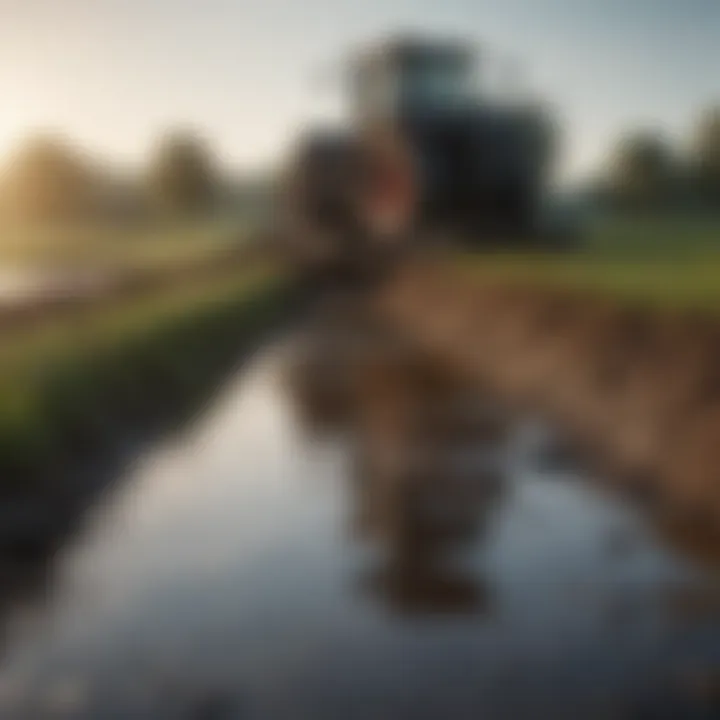
Site assessment stands as the first step in crafting an effective drainage system. One must take a thorough look at the characteristics of the land before even thinking about digging a trench. Factors like topography, soil type, and existing vegetation play a pivotal role.
Topography is a chief consideration, dictating how water migrates across the fields. For instance, sloping terrains may necessitate different drainage approaches compared to flat lands.
Soil type, particularly its permeability, must not be brushed aside either. A heavy clay soil can retain more water compared to sandy soil; thus, using either drainage tiles or specific layout strategies may differ.
Vegetation can also affect how water is absorbed or redirected. Assessing plant types and their root structures gives valuable insights into how they might either assist or hinder water drainage.
A common practice involves producing a detailed site map to identify potential problem areas, which enables one to proactively address issues before they spiral out of control.
Materials for Drainage Systems
Choosing the right materials is like picking the right tools for a job; it’s a fundamental element of successful drainage design. Various materials can be utilized in drainage systems, from traditional clay pipes to modern geo-textiles. Each material comes with its own set of advantages and disadvantages, and knowing these can make all the difference.
- Perforated Pipes: These are essential in subsurface drainage. They allow water to enter while keeping out soil, thus preventing clogging.
- Gravel and Stone: Acting as a filtration medium, these materials help to disperse water and prevent erosion, making them crucial in trench drainage systems.
- Polymeric Materials: In contemporary designs, materials like plastic and composite materials have gained traction due to their durability and lightweight traits.
Selection often hinges on specific site conditions and the goals of the drainage design. Price and availability also play into it; materials that are cheap and easily accessible but not suitable for the site can lead to costly revisions later. Therefore, investing some time in research and understanding the long-term implications can enhance the performance of drainage systems significantly.
Design Methodologies for Agricultural Landscapes
Designing drainage systems for agricultural landscapes requires more than just layman's logic. It's about applying scientific principles tailored for specific crops and soil conditions. Different methodologies exist, and each can be adapted to suit particular needs.
- Surface Drainage Design: This approach focuses on removing excess surface water using ditches or other surface drainage systems. It’s highly effective in flat areas prone to waterlogging.
- Subsurface Drainage: This method uses buried pipes to control water tables and is particularly advantageous for crops that are sensitive to waterlogged conditions.
- Contour Drainage: This is where drain lines are laid along the natural contours of the land. By following the terrain, this method can reduce soil erosion and runoff, making it a favorable choice for hilly landscapes.
Ultimately, the choice of design methodology should reflect both the specific agricultural practices employed and the local climate. It's a balancing act, one that significantly influences how water is managed, thereby affecting crop yields and, ultimately, the bottom line.
"An effective drainage system is not just about moving water away, but controlling it wisely to benefit both crops and the environment."
Grappling with these components provides a firm foundation for any drainage system designed to manage stormwater effectively. The significance of these elements lays in their ability to intertwine seamlessly, enhancing agricultural productivity while safeguarding ecological integrity. In the following sections, we will delve deeper into hydraulic considerations, regulatory factors, and maintenance necessities that all interplay with these foundational principles.
Hydraulic Considerations in Drainage Design
Understanding hydraulic considerations is fundamental when it comes to planning and implementing drainage systems for stormwater management. Water behaviors, like their flow rates and paths, largely determine how effective a drainage design can be in controlling water runoff. Neglecting these hydrological principles can lead to ineffective systems that may exacerbate flooding or contribute to soil erosion. Here, we dive into the critical aspects that every agricultural stakeholder must ponder when designing drainage systems.
Hydraulic Modeling Techniques
Hydraulic modeling serves as a blueprint for analyzing how water moves across various terrains. Utilizing software such as HEC-RAS or EPA-SWMM allows engineers to simulate stormwater flow and assess the drainage layout against potential real-world scenarios.
- Types of models: There are various models, several linear and non-linear approaches to reflect the complexity of water behavior. For instance, hydraulic models can demonstrate the effects of land use on flow patterns.
- Advantages of modeling: Models can predict issues before they arise, allowing for preemptive solutions. This foresight can greatly reduce costs associated with trial and error during actual implementation.
"Accurate modeling can save farmers from floods and the high cost of reconstruction that follows."
Calculating Peak Flow Rates
Calculating peak flow rates is a game-changer in designing effective drainage systems. Peak flow refers to the maximum rate at which water flows during a rainstorm or flood event. Moreover, understanding this rate is essential, as it informs the sizing and placement of drainage components.
- Data Collection: Collect historical rainfall data and observe local drainage patterns. This data plays a key role in determining potential maximum flow scenarios.
- Application of Formulas: Use formulas such as the Rational Formula to calculate the peak flow, factoring in rainfall intensity and watershed area.[ Q = CiA ]
- Design Implications: With accurate peak flow calculations, designers can ensure drainage systems can cope with potential water loads.
- Q = Peak flow in cubic feet per second (cfs)\
- C = Runoff coefficient\
- i = Rainfall intensity in inches per hour\
- A = Area in acres
Impact of Soil Type on Drainage Performance
The type of soil significantly affects drainage performance; understanding this relationship can be the difference between success and stagnation in agricultural productivity. Different soils have varying infiltration rates and storage capacities.
- Compact soils: Clay or compacted soils might retain more water but drain slowly, often leading to ponding.
- Loamy soils: Loam typically offers a good balance of water retention and drainage, making them ideal for many crops.
- Sandy soils: These tend to drain quickly but also lose moisture rapidly, necessitating careful water management.
The realization that soil types directly impact the water movement compels engineers and farmers alike to conduct thorough soil assessments. Such studies help in tailoring the drainage design to match the specific conditions at hand, ultimately enhancing crop performance and lowering the likelihood of waterlogging.
Regulatory and Environmental Considerations
Understanding the regulatory and environmental aspects of drainage system design is as crucial as the technical engineering itself. Farmers and agricultural enthusiasts must be aware of regulations that govern stormwater management, as non-compliance can lead to significant repercussions, both legally and ecologically. These regulations often stem from a desire to protect water quality, preserve ecosystems, and manage water resources responsibly.
The interplay between regulations and environmental considerations creates a framework within which effective stormwater drainage systems can be developed. This ensures that the methods employed not only meet agricultural needs but also adhere to environmental standards. After all, sustainable agricultural practices hinge on a balanced approach that respects nature's limits while optimizing productivity.
Applicable Regulations and Standards
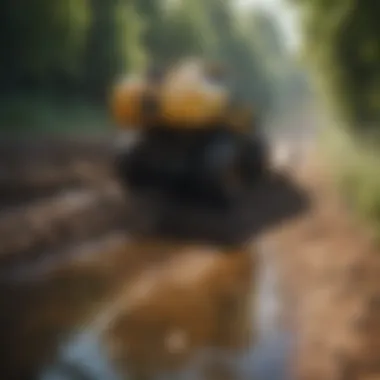

There are a multitude of regulations and standards that guide the design and implementation of drainage systems. These can vary by region but generally include:
- Clean Water Act (CWA): This U.S. legislation aims to restore and maintain the integrity of the nation's waters by preventing point and non-point source pollution.
- National Pollutant Discharge Elimination System (NPDES): Under CWA, this requires permits for discharges, including stormwater runoff from agricultural sites.
- State-specific Regulations: Many states have their own sets of rules that may impose stricter requirements depending on local environmental conditions and agricultural practices.
Best Management Practices (BMPs)
Implementing Best Management Practices is essential in effectively managing stormwater. BMPs can take many forms, but their core purpose is straightforward: reduce the quantity and improve the quality of stormwater runoff. Some common BMPs in agricultural contexts include:
- Vegetative Buffers: Planting vegetation along waterways can significantly reduce runoff and filter pollutants.
- Retention Ponds: These temporary basins hold stormwater, allowing pollutants to settle before water is released.
- Contour Farming: This practice involves plowing across the slope of the land to reduce runoff and soil erosion.
Utilizing BMPs not only meets regulatory demands but also enhances soil fertility and crop yield over time, showcasing a win-win scenario for farmers and the environment.
Environmental Impact Assessments
Before embarking on major drainage alterations or constructions, conducting an Environmental Impact Assessment (EIA) is paramount. An EIA evaluates the potential ecological consequences of a project. This process typically involves:
- Gathering Baseline Data: Understanding the current environmental state of the land and surrounding areas.
- Assessing Impacts: Determining how the proposed drainage system may affect water quality, local wildlife, and habitats.
- Recommendations: Suggesting alternatives or modifications to minimize negative impacts.
Properly executed, an EIA can identify significant risks, leading to more sustainable and responsible management practices. It encourages stakeholders to make informed decisions that balance agricultural productivity with environmental stewardship.
Integration with Agricultural Practices
Integration of drainage systems into agricultural practices is not just an afterthought; it’s essential for achieving optimal crop yields and sustainable land use. Farmers need to bring together effective drainage design with their farming methods to create a harmonious relationship between water management and crop production. This connection allows farmers to address the immediate water needs of their fields and ensures long-term sustainability, which is increasingly important in a world where climate variability is a constant threat.
Enhancing Crop Production Through Drainage
Drainage directly influences agricultural productivity. An effective drainage system helps prevent waterlogging, which can suffocate roots and negatively impact crop health. By maintaining optimal moisture levels, crops can grow stronger and healthier. For example, implementing tile drainage in heavy clay soils can significantly improve crop yields. Farmers have cited instances where they observed a 20-30% increase in corn yields after enhancing drainage on their fields.
In addition to increased crop yields, effective drainage systems can also lead to earlier planting dates. Fields that drain well dry out faster after rain, allowing farmers to work the land sooner. This early planting gives crops an edge in growth, making them better positioned to compete for nutrients and light, which enhances overall production.
Adjusting Drainage for Different Crops
Every crop has unique drainage needs, making it crucial to tailor drainage systems according to what is being grown. For instance, root vegetables such as carrots prefer well-drained soils that are loose, while rice thrives in flooded conditions. Understanding these nuances is imperative for any farmer looking to maximize their output.
Researchers suggest that dissecting fields into zones can help determine the most effective drainage strategy depending on the crop. This zoning can involve using raised beds for certain types of vegetables while implementing water-retaining techniques for others.
"By adapting drainage practices, we can not only enhance our yields but also protect our land for future generations."
Therefore, evaluating the specific requirements of each crop can lead to better decision-making regarding drainage strategies.
Maintenance of Drainage Systems
In any effective stormwater management strategy, the maintenance of drainage systems stands out as a crucial aspect that can't be overlooked. Well-maintained drainage systems are not just good for the environment—they also offer tangible benefits for agricultural productivity. Neglecting this vital function can lead to a cascade of issues, including soil erosion, crop losses, and even increased pollution in nearby water bodies. The importance of actively maintaining drainage systems lies in several key areas:
- Preventive Measures: Just like regular health check-ups, periodic inspections help catch small problems before they become big headaches. This ensures that everything is running smoothly.
- Enhanced Soil Health: Proper drainage encourages healthy soil structure and nutrient retention, which are vital for any crop. If water sits too long, it can wash away valuable topsoil.
- Economic Benefits: Investing in maintenance can save farmers money in the long run. When drainage systems work effectively, they minimize flooding and reduce crop damage, leading to more consistent yields.
By integrating regular maintenance into agricultural practices, farmers can cultivate an environment where both their crops and their drainage systems thrive.
Regular Inspection Protocols
Establishing a routine for inspecting drainage systems is paramount for sustaining their effectiveness over time. Regular inspections should ideally take place at the beginning of each growing season, especially after heavy rainfall events. Here are some key protocols to implement:
- Visual Inspections: Walk the drainage paths and check for obvious signs of blockages or erosion. Sometimes a simple look see can unveil problems.
- Flow Checks: During rainfall, observe if water moves efficiently through the system. Slow drainage might indicate clogs or structural issues.
- Record Keeping: Maintain a log of inspections, noting the findings and any corrective actions taken. This record can be invaluable for future reference and trend analysis.
Following these inspection protocols helps ensure that drainage systems are always in tip-top shape, ready to perform when those rain clouds roll in.
Troubleshooting Common Issues
Like any other mechanical system, drainage systems can experience hiccups. Knowing how to troubleshoot these common issues can save a ton of trouble down the line.
- Clogged Drains: This often results from sediment buildup, debris, or root intrusion. Using a high-pressure water jet can sometimes clear those stubborn blockages faster than you can say "drainage issues".
- Poor Water Flow: If you notice water pooling in places it shouldn't, it could be due to an inverted slope or damaged material. Adjustments in the grading or replacing broken sections can resolve this.
- Erosion Around Drains: Unsightly erosion can lead to bigger headaches. Installing rip-rap or using silt fencing can help stabilize these areas and prevent further loss.
- Pest Problems: Sometimes, critters decide that a drainage system makes a fine home. Regular checks will help keep these unexpected residents at bay.
Regular maintenance not only guards against system failures, but it also protects the land from runoff that could harm the ecosystem.
By employing these troubleshooting strategies, farmers can manage their drainage systems effectively, minimizing disruptions and keeping their agricultural operations running smoothly.
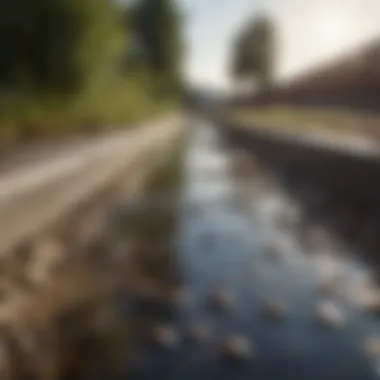
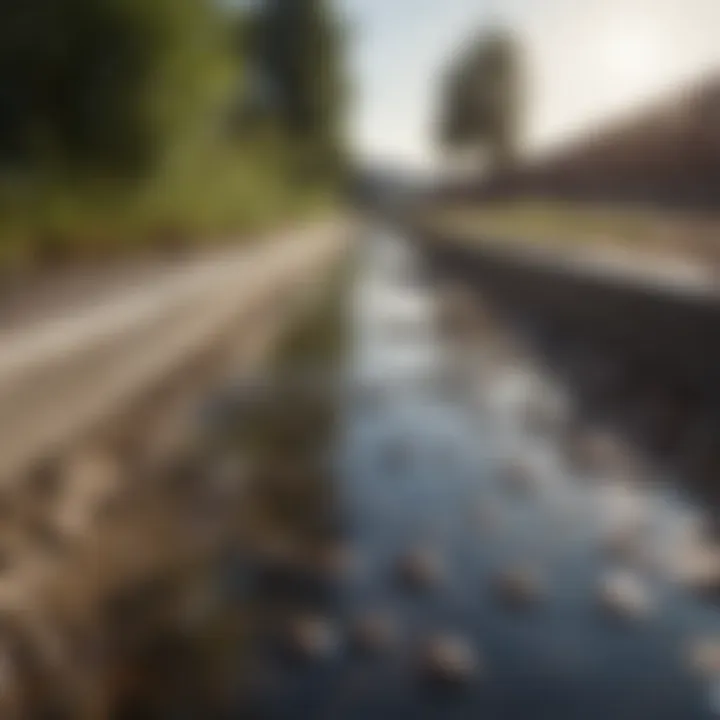
Future Trends in Stormwater Drainage Design
The realm of stormwater drainage design is shifting, driven by technological advancements and an increasing awareness of environmental sustainability. Recognizing future trends in this area is vital for farmers and agricultural enthusiasts aiming to optimize their practices while being eco-conscious. As climate change continues to present challenges, innovative and sustainable drainage solutions become more pressing. This section explores critical innovations and practices that are shaping the future of stormwater management.
Innovations in Drainage Technology
When it comes to current innovations, the fusion of technology and engineering in drainage systems stands out prominently. Investation in smart drainage technologies is not merely a trend, but a necessity. Examples include:
- Smart Sensors: These are used to monitor soil moisture levels and precipitation. Farmers can tap into real-time data to make informed decisions about water usage and drainage needs.
- On-Site Stormwater Management Systems: Designs like swales and rain gardens are gaining traction. Not only do these systems help manage excess water, but they also create aesthetic and functional green spaces.
- Permeable Pavements: These allow rainwater to seep through surfaces, reducing runoff and promoting natural filtration. Such technology is not just reserving water but enhancing groundwater recharge.
- Modular Drainage Systems: Utilizing modular designs, these systems can be easily adjusted or expanded based on specific site conditions and changing climate patterns. This flexibility can greatly reduce costs over time.
Adopting these technologies can lead to substantial water savings, reduced flood risks, and improved crop yields. Moreover, tech-savvy systems can help meet stricter regulations while adapting to agricultural needs.
"Adapting to innovative drainage technologies empowers farmers to manage water resources more effectively while enhancing productivity and ecological benefits."
Sustainable Practices in Drainage Design
Sustainability is becoming the backbone of modern drainage design. With escalating environmental challenges, there is a pressing need for systems that not only manage stormwater but also improve ecological balance. Here are some noteworthy sustainable practices:
- Rainwater Harvesting: Capturing and reusing rainwater can alleviate pressure on drainage systems. This practice contributes to water conservation and enhances the sustainability of agricultural operations.
- Constructed Wetlands: These are engineered to mimic natural wetlands. They provide a habitat for wildlife while filtering pollutants and managing excess water, making them a two-for-one win.
- Green Roofs: While often relegated to urban areas, integrating green roofs into agricultural buildings can help absorb rainwater and reduce stormwater runoff.
- Soil Biomimicry Approaches: These involve understanding soil structures and how to enhance their natural abilities to handle water. Utilizing crop rotation and cover crops can improve soil health and water retention.
By embracing these sustainable practices, farmers can potentially lead industry shifts that sow the seeds for long-term environmental stewardship. This approach fosters resilience against climate change while ensuring that agricultural productivity is not compromised.
Case Studies in Effective Drainage Systems
Case studies serve as valuable blueprints in the world of stormwater management. They highlight real-world applications, showing what works and what doesn’t. This section dives into why these studies are critical for both understanding effective drainage systems and guiding future implementations. By analyzing specific scenarios, farmers can glean lessons and insights that simply theory cannot provide. Real-life examples paint a clearer picture of successes and failures, enabling practitioners to refine their approaches.
Analyzing Successful Agricultural Implementations
Successful agricultural implementations often showcase innovative strategies that not only address drainage needs but also enhance productivity. For instance, consider a small dairy farm in Wisconsin that redesigned its drainage system to manage stormwater effectively. By installing bioretention basins and swales, the farm has reduced runoff significantly, which in turn mitigated soil erosion. This example underscores a few critical elements:
- Tailored Solutions: Every farm has unique geographical features. The adoption of custom drainage designs tailored to specific needs has, in this case, led to improved water quality.
- Increased Yield: The impacted areas are benefitting substantially in crop yields due to better water retention and soil health, a clear indicator of how good drainage translates into agricultural success.
- Long-term Planning: Farmers who approach drainage with a long-term vision—considering future weather patterns and land-use changes—tend to report better outcomes. This dairy farm, for instance, integrated forecast data in their planning, thus preparing for the extremes that climate change brings.
Moreover, another compelling case is seen in the vineyards of California. Here, implementing controlled drainage systems has led to retained moisture during dry spells. They use methods like subsurface drainage coupled with regular soil moisture monitoring. As a result:
- Water Conservation: Keeping water in the soil longer during droughts helps sustain the vines.
- Quality Grapes: This careful balance of moisture results in higher quality grapes, demonstrating that effective design not only saves resources but enhances the crop.
Lessons Learned from Failed Designs
While success stories shine a light on effective practices, learning from failures remains equally essential. For instance, a cornfield in Iowa exemplifies how poor drainage design can wreak havoc. Here a simple solution was overridden by a lack of proper assessment.
The key takeaways from this case include:
- Neglecting Soil Types: The initial design failed to consider the varied soil types across the field. The clay-heavy areas became waterlogged, while sandy areas suffered from drought. This discrepancy illustrates the need for comprehensive site assessment prior to project initiation.
- Ignoring Local Climate Variables: The drainage system did not account for local climate fluctuations, leading to overflow during peak rainy seasons. This emphasizes the crucial requirement of adapting designs based on historical climatic data.
- Maintenance Overhaul: The design was not sustainable without maintenance. Lack of regular inspection led to silt buildup and clogged drains, underscoring the aspect that a plan is only as good as its maintenance protocols.
"Each project, whether a success or a failure, offers insight that should not be overlooked in the pursuit of effective drainage systems."
By studying both successful implementations and learning from failed designs, farmers can form a more rounded understanding of drainage systems. This isn't just about technical drawing and installation; it's about creating systems that withstand the test of time and nature's unpredictability. Looking ahead, it's imperative to integrate lessons from history into future designs, refining approaches for holistic, sustainable drainage solutions.
Finale and Recommendations
A well-structured drainage system can offer several compelling benefits:
- Increased Crop Resilience: Good drainage systems help crops withstand extreme weather conditions.
- Soil Health: A thoughtfully designed system protects soil structure and promotes the overall health of the land.
- Regulatory Compliance: Familiarity with local regulations regarding water management can help avoid legal troubles and improve farm practices.
- Cost Efficiency: Proper drainage reduces the need for constant manual intervention, which can save time and money in the long run.
By synthesizing information from previous sections, it becomes clear that a thorough understanding of drainage system design is essential for today's farmers. Each element from regulatory considerations to field assessments integrates into a holistic approach aimed at sustainability and productivity.
Summary of Key Insights
To summarize the key insights into the design of drainage systems:
- Site Assessment: Always consider the specific characteristics of the land, such as topography and soil type.
- Hydraulic Modeling: Use simulations to predict how water will treat the land during rainfall events, aiding in better system design.
- Best Management Practices (BMPs): Implement proven practices that align with soil and water conservation.
- Ongoing Maintenance: Regular system inspections can catch issues early and prevent costly repairs later.
The integration of these components lays a robust foundation for effective stormwater management.
Practical Recommendations for Farmers
Farmers looking to implement or upgrade their drainage systems should consider the following recommendations:
- Conduct a Thorough Site Assessment: Understand your land's unique characteristics, including soil type, compaction, and water flow patterns.
- Implement Adaptive Management: Be willing to adjust practices based on ongoing observations. This not only aids in reactive measures but also builds resilience against future challenges.
- Invest in Technology: Using smart sensors and hydraulic modeling tools can greatly enhance your decision-making process.
- Collaborate with Experts: Work with engineers or agronomists who specialize in drainage to design systems tailormade for your operations.
- Stay Informed About Regulations: Keep abreast of local environmental regulations to ensure compliance and best management practices.
Simply put, the journey toward enhancing stormwater management and drainage systems is not a solitary one; collaboration and continuous learning must drive it forward. By considering these recommendations, farmers can make informed decisions that contribute to the health of the farm and the environment.



